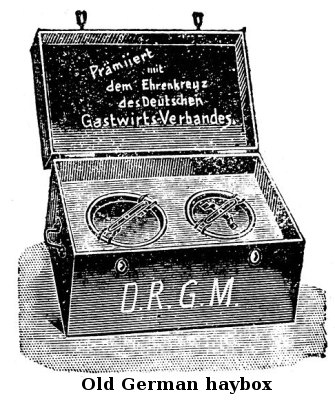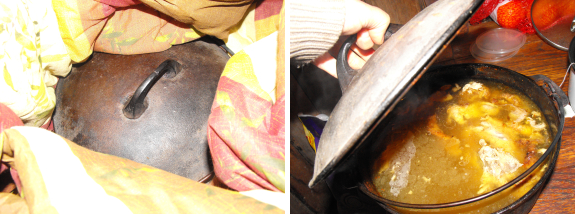
Haybox
 As
part of my continued obsession with lower-energy cooking, I
decided to try to make a haybox to cook my chicken carcass down into
stock Sunday. Someone (Heather?) had emailed me in response to my
Dutch
oven post,
telling me that you can bring a pot of incipient soup to a boil, wrap
it in towels, and leave it alone for the afternoon. The cast iron
and towels will hold in the heat, and the soup will cook itself.
As
part of my continued obsession with lower-energy cooking, I
decided to try to make a haybox to cook my chicken carcass down into
stock Sunday. Someone (Heather?) had emailed me in response to my
Dutch
oven post,
telling me that you can bring a pot of incipient soup to a boil, wrap
it in towels, and leave it alone for the afternoon. The cast iron
and towels will hold in the heat, and the soup will cook itself.
While researching rocket
stoves,
I stumbled across a mention of hayboxes, which seem to work on a very
similar principle to Heather's idea. You fill up a box with hay
(or other insulation), put in your boiling pot, and leave it alone for
several hours. I've seen figures suggesting that using a haybox
with long-cooking recipes like chicken stock will save 80% of the
energy you would use to simmer the stock on the stove. You should
leave the pot in the haybox somewhere between once and twice as long as
you would have left it on the stove. If you're worried about
bacteria, bring the whole thing back to a boil for a few minutes on the
stove before serving.

So how did my experiment
go? I brought my carcass and water to a boil and tucked it into
an old comforter in a cardboard box. (The image on the left shows
the pot before I bundled the rest of the comforter over the top.)
Our house temperature was low on Sunday --- 50 degrees Fahrenheit ---
but when I peeked in six hours later, the pot was still steaming and
the stock was a lovely yellow. Success!
Want more in-depth information? Browse through our books.
Or explore more posts by date or by subject.
About us: Anna Hess and Mark Hamilton spent over a decade living self-sufficiently in the mountains of Virginia before moving north to start over from scratch in the foothills of Ohio. They've experimented with permaculture, no-till gardening, trailersteading, home-based microbusinesses and much more, writing about their adventures in both blogs and books.
Want to be notified when new comments are posted on this page? Click on the RSS button after you add a comment to subscribe to the comment feed, or simply check the box beside "email replies to me" while writing your comment.

My mother told me they used to have one at home when she was young. Apparently they were in widespread use in the Netherlands from ca. 1900 until after WW2. When everybody got connected to the natural gas mains in the sixties they fell out of use. Google "hooikist" for some nice pictures. Hmmm. I've still got an old duvet lying around. Might as well give it a try next time I'm boiling beans for chili. But I'm should check first if the polyester filling can withstand the temperature
OTOH, a big vacuum-insulated thermos would probably even be better, provided the neck is big enough for whatever you're cooking. Time for some experiments in the kitchen.
Interesting that your mother's actually heard of them! I'd never heard the term before (but my mom hasn't chimed in yet. ) What did she cook in them?
) What did she cook in them?
Nice to get the "hooikist" clue! So many nice pictures by that name!
IIRC, almost everything that was to be cooked in water, but not baked or fried. It was mostly done to save fuel (coal in those days), otherwise someone might have to go into the coal cellar and get a new load in a special bucket called a "kolenkit", which was a dirty job. My Dad told me that when he was young, which ever of the siblings who had been naughty that day got that job. Of course, coal was pretty expensive.
Of course, coal was pretty expensive.
Especially suited for cooking like this was some kind of cheap meat that needed to be cooked for a long time with thyme and bay leaf. It's called "stoofvlees" (lit. stewed meat, not sure about the correct english term), it is very stringy cow or horse meat. It had to be boiled until it almost falls apart. My Mom liked it, but I always thought it was gross. Part of the reason why I'm a vegetarian to this day.
I love your historical info! Being in intimate contact with our fuel --- hauling coal or wood --- sure does make us use less energy.
I cooked an old chicken the way you described cooking the old meat and I have to say it was edible but not very good. Much tastier to grind it up and make sausage out of it. I can see how that might turn you off meat....
Aha! I thought it was the other Heather who suggested hayboxes. User pages are coming in handy already.
I think you're totally right about new pressure cookers. I've got a couple of old ones but I'm very afraid! I figure a new one will wander into my life eventually and I'll give it a shot. Your recipes sound great (and I love your method of making oatmeal!)
There was this mythbusters episode where the rigged an electric boiler to blow. It blew out its bottom, went through a roof and up a couple of hundred feet high!
But they had to sabotage two different safety devices (temperature/pressure relief valve and thermostat) for that to work, and they had to take both pressure and temperature up to insane values.
Like boilers, pressure cookers these days have multiple safety mechanisms. Still, I think you're right to be weary. Everything dealing with high pressure and steam has to be handled carefully and needs to be maintained well.